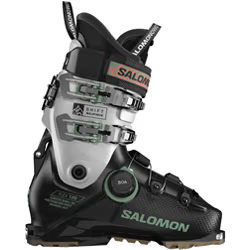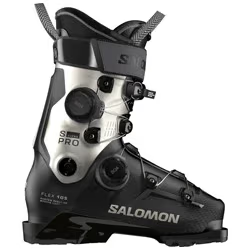Boots Salomon
(20)How to buy the perfect ski boots guide
Looking for a new pair of ski boots and you are lost between to many brands and models? Read through following advices and we guarantee that you will soon find the one.
Read more-
-
Salomon Ski boots S/Pro Supra Dual Boa 105 GW 2026 black/light bronze women's-10%Instead of:599,95€Now:539,95€
-
Salomon Ski boots S/Pro Supra Dual Boa 120 GW 2026 humus/black/orange-10%Instead of:649,95€Now:584,95€
-
-
-
-
-
-
-
-
-
-
Salomon Grip Pad S/Pro, S/MaxPrice:14,95€
-
-
-
-
-
-
When choosing the right ski boots, we must pay attention to three main characteristics: purpose, flex, and size. We will present the purpose in more detail below, so let’s first focus on the properties common to all ski boots, regardless of their category.
Ski boot flex is usually expressed with the FLEX index. Most manufacturers already include it in the model name of their ski boots, and it is indicated with a number. Flex tells us how much force is required to bend the ski boot forward.
When choosing the right flex, you need to consider the skier’s strength, physical condition, skiing style, and weight.
- The stiffest ski boots for recreational skiers have a flex index of 130 – chosen by advanced recreational skiers, aggressive riders, former racers, and heavier skiers.
- Most good recreational and active skiers will choose ski boots with a flex of 100–120,
- Beginners and lighter skiers will prefer softer ski boots with a flex of 80–100.
Women’s ski boots are usually softer, as women are lighter compared to men.
- Advanced female skiers: ski boots with a flex of 80–100,
- Good recreational skiers: flex 60–80,
- Beginners and occasional female skiers: softer women’s ski boots.
Ski boot size is one of the most important characteristics. The ski boot represents the contact between skier and ski, the medium through which power is transferred. Even the best ski boot will not perform well if it is too large, as ski control will be compromised.
Ski boot size is given in millimeters (mondo point).
For ski boots, forget about standard shoe sizes – the most important measurement is the actual length of your foot.
To choose correctly: stand on a sheet of paper against a wall, mark the tip of your toes, measure, and add 3 mm. When you put on the ski boot, your toes should touch the front; when flexing forward, they will move away.
Ski boots also differ in width. Although more models now offer shell customization (e.g. Fischer Vacuum, Salomon Custom Shell), you should still carefully choose if you have wider or narrower feet.
The purpose of ski boots tells us what kind of skier they are designed for: aggressive carving, freeride, ski touring, or all-day comfort. To make the choice easier, we have divided ski boots into several groups.
-
All-round men’s ski boots
Here, ski boots are available for beginners, recreational, and advanced skiers. They are characterized by comfort and direct power transfer. Many offer shell or liner customization. An excellent choice for all-day skiing or sporty riding. Flex: 80–130.
-
All-round women’s ski boots
Women’s ski boots provide maximum comfort and warmth. Many models allow customization of the shell or liner. They are often color-coordinated with skis and ski outfits. For cold winter days, we recommend ski boot heaters.
-
Racing ski boots
Racing ski boots are the closest to those used by World Cup racers. They provide the most direct power transfer. The liner is thinner, the sole has no rubber. Ideal for expert skiers and strong recreational skiers. Flex: 100–130.
-
Freeski ski boots
Freeski ski boots are made for freeride skiing outside groomed slopes. Usually stiffer models with rubber soles for secure walking and mobility. Excellent for powder skiing, jumps, and drops.
-
Touring ski boots
Touring ski boots are lighter, with more ankle mobility, rubber soles, and crampon compatibility. Perfect for long tours and uphill climbs. Some models are compatible with ultralight touring bindings.
-
Kids’ ski boots
Kids’ ski boots are intended for the youngest skiers – from beginners to junior racers. Important: boots should not be too big, as this can cause injuries if the ski boot does not hold the foot properly.














